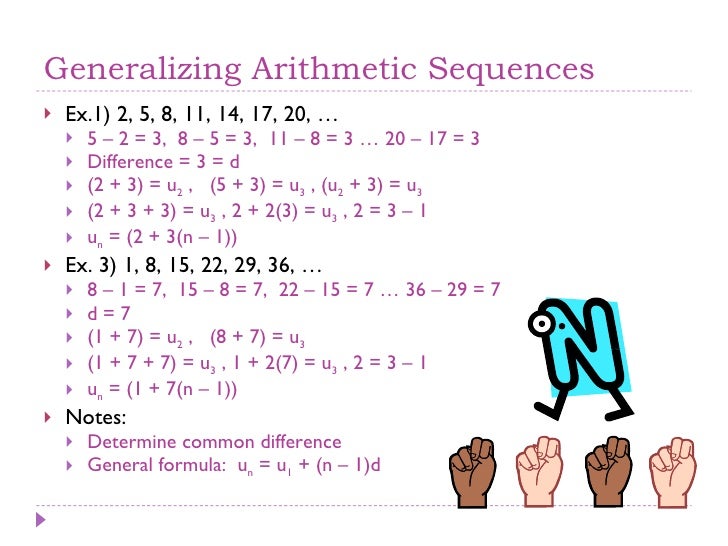
(Ignore the wildly improbable biology here.) After a year, how many rabbits would you have? A month later, those rabbits reproduce and out comes - you guessed it - another male and female, who also can mate after a month. After a month, they mature and produce a litter with another male and female rabbit. The problem goes as follows: Start with a male and a female rabbit. In one place in the book, Leonardo of Pisa introduces the sequence with a problem involving rabbits. Written for tradesmen, "Liber Abaci" laid out Hindu-Arabic arithmetic useful for tracking profits, losses, remaining loan balances and so on, he added.
SERIES AND SEQUENCES MATH AND SCIENCE INITIATIVE HOW TO
However, in 1202 Leonardo of Pisa published the massive tome "Liber Abaci," a mathematics "cookbook for how to do calculations," Devlin said. (Image credit: Stefano Bianchetti/Corbis via Getty Images) However, in 1202 in a massive tome, he introduces the sequence with a problem involving rabbits. So our the 100th term in our sequence will be negative 579.Portrait of Leonardo Fibonacci, who was thought to have discovered the famous Fibonacci sequence. So that right there is 579, and then we have this negative 594 minus 14 would be 580, and then 580 minus one more would be 579. So what's 594 minus 15? You should do it, weĬould do this in our head. Negative one times 594 is negative 594, negative one times And if you don't believe me, distribute out this negative sign. Process this in my head is I say that this is the exact same thing as the negative of 594 minus 15. So this right here is 594, and then to figure out what 15, so we wanna figure out, we wanna figure out what 15 minus 594 is, and this can sometimes be confusing, but the way I always But if you didn't wanna do it that way, you just do it the old-fashioned way. You could say that's going to be six less than 100 times six, which is 600, and six less is 594. What's 99 times six? So 99 times six, actually you could do this in your head. Two, you had a one here, three, you had a two here, 100, you're gonna have a 99 here. It's going to be, and I'll do it in pink, the 100th term in our sequence, I'll continue our tableĭown, is gonna be what? It's going to be 15 minus 100 minus one, which is 99, times six, right? I just followed the pattern. It in this general term, you could just look at this pattern. So if you wanna figure out theġ00th term of this sequence, I didn't even have to write So we're going to have, this term right here is n minus one, so minus n minus one times six. So if we had the nth term, if we just had the nth term here, what's this going to be? It's going to be 15 minus, you see it's going toīe n minus one right here, right when n is four, Have our fourth term, we have the term minus one right there, the fourth term we have a three, the third term we have a two, the second term we have a one. So if you see the pattern here, when our term, when we Three times from the 15, so minus three times six. What's the fourth term? This is 15 minus, we're subtracting the six Now what's happening here? This is 15, this is 15 minus two times negative six, or sorry minus two times six, minus two times six. One times negative six, either way, we're What's the second term? This is 15, it's just we just subtracted six once, or you could say minus one times six. Write it better this way, minus zero times six. So you could say this is 15 minus six times or let me Subtract six at all, or you could say you Let me write this down just so, notice when your first term, you have 15 and you don't So whatever term you're looking at, you subtract six one less In the fourth term, you subtract six three times. So in the third term, you subtract a six twice. The third term is going to be 12 minus from the first term, or six subtracted twice.


So the second term is going to be six less than the first term.

So it looks like every term, you subtract six. Three to negative three, well we, we subtracted six again. Then to go from nine to three, well we subtracted six again. So we went down by six, we subtracted six. Think about just how much the numbers changed by. Term to the second term, what happened? 15 to nine, looks like So let's see what's happening here, if we can discern some type of pattern. Out what the 100th term of this sequence is going to be.

And they wanna ask, they want us to figure And then our fourth term, our fourth term is negative three. I'm just really copying this down, but I'm making sure we associate So if we have the term, just so we have things straight, and then we have the value, and then we have the value of the term. Asked what is the value of the 100th term in this sequence, and the first term is 15, then nine, then three, then negative three.


 0 kommentar(er)
0 kommentar(er)
